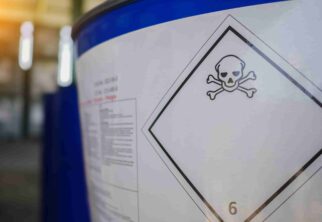
Though mistakes in hazardous material handling can happen, it’s important to recognize that most of these mistakes are avoidable, if not preventable. Hazardous waste handling mistakes can result in significant financial penalties and ruin your standing in the community.
Because the consequences of non-compliance can be severe regarding the risks to public health and the environment, every hazardous waste generator needs to prioritize understanding and following all hazardous material handling guidelines. Here are some common hazardous waste handling mistakes and the steps you can take to avoid them.
1. Improperly Labeled Hazardous Waste Containers
Failure to accurately label hazardous waste containers is not simply one of the leading hazardous material handling mistakes but a violation of the law. EPA requires waste generators to accurately mark containers for storing hazardous waste onsite, and the Department of Transportation (DOT) requires the same for shipping. Common mistakes generally stem from unintentional employee error, confusion, or oversight and include failure to attach a label, incomplete information on the label, missing DOT placard labels, or incorrect waste details. Such oversights can have serious consequences, including potential safety risks and environmental dangers that lead to violations and costly fines. To remain compliant and to ensure proper labeling, organizations should consider assigning specific personnel to handle labeling designated containers beforehand so employees know how and where to dispose of hazardous waste materials correctly.
2. Container Violations
Open, loosely sealed, or leaking containers violate the law. Yet, this is a common mistake made by hazardous waste generators. Except adding or removing waste, the EPA and state agencies mandate that all hazardous waste containers must be closed and securely fastened when not in use. Containers must also be properly maintained and in good condition with no signs of degrading to ensure against ruptures or leaks. This practice is intended to prevent the release of harmful fumes or substances that could pose a risk to human health in the workplace or spilling hazards that could result in contamination and closure of a facility. Adhering to this guideline is essential for maintaining compliance with everyone involved in the waste management process. To avoid fines and violations, be sure container lids are secure and assign personnel to routinely inspect containers for any signs of rusting, cracking, or leaking.
3. Lack of Training For Employees
Another area prone to hazardous waste handling mistakes that result in fines is the number of employees who lack proper training in handling hazardous waste material. By law, all employees and personnel in companies, facilities, and organizations that generate hazardous materials must undergo training in handling and storing the material properly. Types and extent of training can be affected by the organization’s generator status or job requirements. For example, employees at small-quantity generator sites need to be trained in the proper handling and storage of hazardous waste material and emergency response protocols. However, annual personnel training is mandatory for large-quantity generators. Individuals involved in hazardous waste or responsible for loading and unloading, as well as those who sign the “Hazardous Waste Manifest,” must undergo training in the DOT Hazardous Materials regulations.
4. Insufficient Emergency Response Plan
Having a hazardous waste emergency response plan is mandated by both OSHA and EPA regulations. Not doing so can result in regulatory penalties. However, numerous organizations often fail to plan effectively for real-world situations. Your emergency strategy should cover up-to-date facility maps, specific procedure signs, and clear communication channels. Businesses that regularly practice their emergency responses tend to have higher success rates, as they can pinpoint and rectify steps that aren’t effective in actual scenarios. Organizations should assign an emergency coordinator, there should be a detailed evacuation plan, and employees should know where to go and what to do in the event of an emergency. There should be a list of relevant phone numbers and protective equipment if needed.
5. Insufficient Personal Protective Equipment
Having the correct equipment can be life and death in a hazardous waste emergency. Protecting employees from hazardous materials requires proper personal protective equipment (PPE) compatible with the hazardous material your facility or institution is generating. Insufficient and inadequate PPE can lead to a range of injuries. To ensure employee safety, it is essential to maintain an adequate supply of gowns, gloves, shoe covers, and goggles on-site. Ventilation masks may also be necessary depending on the specific waste your business handles. Failure to provide PPE can result in significant fines from OSHA.
6. Hazardous Waste Identification and Determination
Incorrect or improper identification of hazardous waste material is a common violation of hazardous waste regulations. Before any material waste is generated onsite, whether in a lab or facility, the material must be properly identified and a waste determination made. The term ‘waste determination’ refers to the procedure used to evaluate, identify, and determine whether any waste generated by any person, facility, or organization, be it a solid, liquid, sludge, or gas, holds any hazardous properties. If so, a determination must be made for each type and flow of waste generated at a facility or establishment, and the hazardous material needs to be classified. Regular reviews of waste generation, processes, and storage locations can be beneficial in maintaining compliance with federal and state regulations.
Avoiding hazardous material handling mistakes protects your employees and the environment and ensures your facility complies with regulations that can otherwise lead to violations and fines. Since 1977, Maine Labpack has offered various hazardous waste handling services to help generators manage their hazardous materials and avoid costly mistakes. If you have questions or concerns regarding hazardous waste material handling and regulations at your facility, contact us today.
